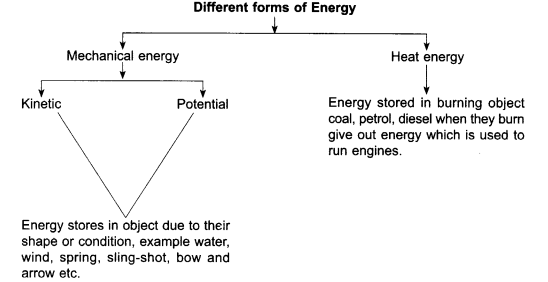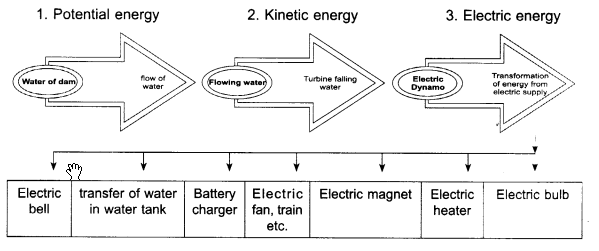Rajasthan Board RBSE Class 8 Science Notes Chapter 9 Work and Energy
Work:
In general we call all hard working activities of life as work. But according to science, work is displacement, or in other words if a body shows displacement when we apply some force on it, then such action is called work. If body does not show any kind of displacement, we say work is not done.
How work is measured:
The measurement of work depends upon displacement. It also depends upon the amount of force applied on it.
- Distance covered by an object.
- Amount of force applied on it.
If the force is applied on an object and it shows displacement in the direction of force then work can be measured by the following formula:
Work = force × displacement in the direction of force
The International unit of work is Joule.
Energy:
Capacity of doing work by the object is called energy Flowing water, blowing wind, coal, diesel, petrol, and electricity all contain energy. This energy can be utilized for doing different work, for example:

It is clear from the above examples that one object works on the other object. For doing work, first or former object does work. It decreases the energy of the first object, which transferred to the other object in the form of action, hence we could say that work and energy are comparable to each other. Therefore International unit of energy is joule.
Energy is found in many forms, among them one is called mechanical energy.
Mechanical Energy:
Potential energy and Kinetic energy are combinedly known as mechanical energy.
Potential Energy: Change in the form or shape is a cause of energy in objects for example- movement of turbine by falling water on it from a great height.
When a winding of watch or car is done a spring inside is pressed or it’s shape is changed, hence capacity of doing work is stored, so it starts working.
When shape or condition of an object is changed hence a kind of mechanical energy is stored in it. It is called Potential energy.
Hence we could say that mechanical energy has two forms:

- Kinetic energy
- Potential energy
- Chemical energy: Energy stored in all type of fuels, battery etc.
- Light energy: Energy stored in Sun or electric bulb, solar energy.
- Electrical energy: Energy from electrical flow through electrodes, working of electric fan, bulb etc.
- Magnetic energy: Energy stored in magnetic field, for example – attraction between iron and magnet.
- Sound energy: Energy stored in sound (vibrations) sound received from the vibrations of musical instruments.
- Atomic energy: Energy received from fusion or fission of atoms. Production of electricity from atomic (nuclear) reactor.
Transformation of Energy:

Various sources of energy can be grouped or classified as:
Traditional Sources of Energy:
Fossil fuel: It is assumed that million of years ago due to movement of earth many animals and plants hurried deep down the earth. Due to very high pressure and temperature of earth they converted into coal and petroleum. They are called fossil fuels. We use chemical energy of these substances by converting it into heat energy, forests are cut for wood to cook food. Hence deforestation is done and day by day availability of wood is decreasing. Petrol, diesel, natural gas, coal, fossil fuels and wood are called traditional sources of energy.
Need of alternate sources of energy or non traditional sources of energy:
Due to growing population and development in different fields, demand and use of traditional energy sources is continuously increasing. The storage of deposits of these resources is limited, a day will come when these deposits would exhaust if their use is done with same speed and manner. It would result into energy crisis. Hence it is essential that we should use them wisely and try to find alternate sources of energy and increase their use.
Non-Traditional Sources of Energy:
Energy received from wind, water, sun, nuclear reactor, oceanic and geothermal energy are non traditional sources of energy. They can be used repeatedly, hence are also known as renewable sources of energy. These resources are exhaustable. Many appliances run by solar energy, wind mills, bio gas plant (bio energy) hydro power generators, connected with hydro power plants, nuclear power plant (in Rajasthan Rawat Bhatta in Chittorgarh District ) tidal energy produced by tides of oceans, geo-thermal energy produced by internal heat of earth are example of non traditional sources of energy.
Measures of Conservation Energy:
- Use electric appliances only when needed.
- When no body is in the room electric appliances should be switched off.
- Use solar cooker, pressure cooker etc to save energy.
- Avoid wastage of traditional sources of energy.
- Close the engines of automobiles while waiting of any one or at traffic points.
- Regular checkup and servicing of vehicles.
- Optimum use of solar energy.
- Use of biotic energy resources.
- Such techniques should be used in building construction so that they remain cool in summers and warm in winters so less use of A.C and heaters and electricity could be saved.
- Regular checkup and servicing of vehicles.
- LED bulbs and tube lights should be used in place of ordinary bulbs and tube light to save energy.